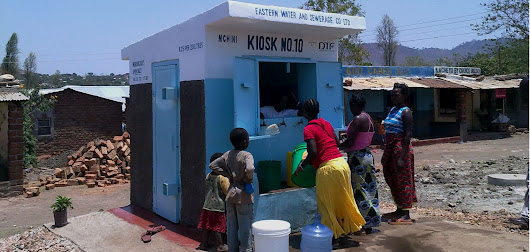Hi and welcome back to the blog! To wrap up I'll be talking about some of the creative solutions I have come across that could be more effective than 'changing social behaviour' or only building toilets.
Firstly, I will not deny that in some cases the issues are rather straightforward and so are their fixes. For example, Nakagiri in their study found that in Kampala, the majority of latrines were full (51%) or even overflowing (15%). Most were dirty (43%) and in their survey, 89% of respondents expressed the need to improve the state and performance of the latrines. They concluded that pit latrines in the urban slums of Kampala were overloaded. Suggestions were made for interventions to improve the pit latrine should tackle the design and operation, with specific suggestions for "minimising water inflows into the pit, increasing the air flow rate, minimising light in the superstructures."
IkoToilet in Kosovo
One way to reduce open defecation and therefore contamination of water sources and improve peoples' experiences is through market-based approaches.
Ecotact's Ikotoilet in Mathare was an attempt to create a self-sustaining public toilet through which people could have a better toilet experience.
It operated slightly different than regular pay-per-use by using memberships. Households could buy a membership for the equivalent of USD $1.35 a month. The idea was that this membership would pay for the salaries and other expenses. The Ikotoilet was also slightly different in that it encouraged mico-entrepreneurs that could rent a kiosk to sell their goods in the toilet station.
Alternatives?
Interestingly, human excreta represents a resource that could be used to promote environmental quality, meet human livelihood needs and generate economic benefits. The key example is the recycling of 'humanure' for agriculture. Some of the examples I'll talk a bit about below attempt to incorporate environmentalism within their solution.
Sanergy and Fresh Life toilets (CLTS)
One way to reduce open defecation and therefore reduce contamination of water sources and improve peoples' experiences is through market-based approaches. This particular example also relies on local entrepreneurs in their communities. Thieme's work has highlighted the importance of micro-entrepreneurs and Sanergy utilises this to provide safe, maintained toilets to all alongside economic opportunity.
A key example is
Sanergy and their Fresh Life toilets in Nairobi. Sanergy was founded by a group of graduate students from the
Massachusetts Institute of Technology. Sanergy introduce Fresh Life pay-per-use toilets that are purchased by local entrepreneurs. It also allows for microfinancing options so the 'entrepreneur' can pay back the cost ($500) over a year. The owner of the toilet cleans them and collects a small fee per use. These toilets are meant to be affordable to users and have a handwashing station. They look very similar to portaloos in that they are small and compact cubicles. The fresh life toilets handwashing station and shape allows them to be preferable for comfort and hygiene whilst being placed in the middle of the city instead of just the ourskirts improves accessibility and economic opportunity.
There is also a large barrel beneath the squat-plate where solid and liquid waste is collected. The barrels are then filled and collected by Sanergy. The waste is transported to a processing plant south of Nairobi where it is converted to fertiliser, biogas or insect-based animal feed in an attempt to be more environmentally friendly and create opportunities for new markets.
In this way, Sanergy is involved in all 3/4 steps of a sanitation chain.
diagram of a sanitation service chain source
Sanergy's waste collection involvement and their idea to treat the waste and create a good out of it where majority of
people in East African cities live in informal settlements and use facilities
serviced by providers that collect waste but do not treat or dispose of it meaning that much of it is dumped back into drainage
systems or open water bodies.
Sanergy is also better in preventing landlords becoming the ultimate beneficiaries. Landlords receive no direct return on investment and many do not live in the area.
Limitations
One of the problems with Sanergy is that it still doesn't quite address the gendered safety concerns because Fresh Life toilets are closed at night. Nairobi's informal settlements can be dangerous at night and so women therefore would still have to revert to 'flying toilets'. In addition, Sanergy still operates on a pay-per-use and so again the weighting of importance between a good toilet experience and education/ food costs would still provide some resistance.
thanks for reading! see my next post for a couple more solutions that better incorporate women's safety and comfort concerns.




Comments
Post a Comment